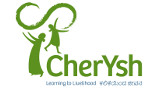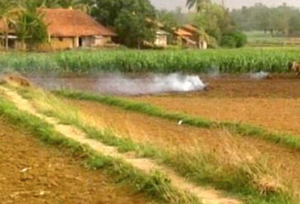On a visit to CherYsh project sites in the sugarcane-rich region of Haliyal, Uttara Kannada district, I saw the fire. Far afield it raged, billowing smoke into the villages – pristine, green, and clean.
Sugarcane trash was being burned.
It seemed a normal practice in the area. Farmers found it expensive to dispose off the cane trash in any other manner. It was ironic – not only were the expansive and clean environs of these villages being swept by swathes of smoke, the soil was being stripped of its biological properties and fertility. Govt asks farmers to stop burning sugarcane thrash – Times of India.
Clearly, an opportunity had presented itself. In the roughly 35,000 hectares of sugarcane cultivation in the area, over a lakh ton of biomass is generated. Every year. A valuable resource. Harnessing this resource requires systems and infrastructure and people to manage it – thereby a clear possibility for creation of livelihoods.
And thus began a long journey in search of solutions to utilise agri-waste, convert it into bio-fuels, and link this to local livelihoods. This search led to the BEACON project (Biomass Energy and CONservation) conceived by CherYsh.
The collaboration envisaged a role for the local sugar factory – EID Parry of the Murugappa Group. They have earned longstanding goodwill amongst farmers. The company has also supported CherYsh in the mission to educate, prepare and secure rural girls and women.
They were on-boarded to advise on farmer level engagement, cane harvesting, and agri-waste utilization.
In nearby Hubballi, the potential to add value from the KLE Technological University was tapped. The team, from KLE’s ‘Centre for Innovation and Product Development’ immersed themselves in the exploration. BEACON thus opened pathways to co-creation with KLE Technological University, and EID Parry. By leaning on shared skills we could build a thriving ecosystem of local community, industry experts, engineering students and social sector professionals. Together we are launching a pilot project of collecting waste from 5-8 acres of farmland and taking it all the way to compacting into briquettes. The series of activities at the village and the efforts towards shared solutions include:
- Identify village location – optimum generation of agri-waste
- Study of collection methods, logistics, time and wage
- Design of simple tools and equipment for women collecting the agri-waste
- Training of community participants, including livelihood for women
- Collection – mechanised and hand held rakes
- Compaction into briquettes/compacted biomass
- Testing briquettes at client site
- Costing and project viability
- Sustainability & market linkages
Through our multi-stakeholder engagement, collective solution-scoping and participatory design of appropriate technology, CherYsh is building an enterprise that delivers –
- Compacted biomass/ agri -briquettes
- Controls environmental hazards
- Generates energy from local resources
- Creates livelihood for women
There’s acres of promise out there. Let’s work towards a future where burning is NOT an option.
– Cheryl Rebello

